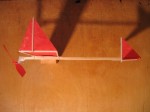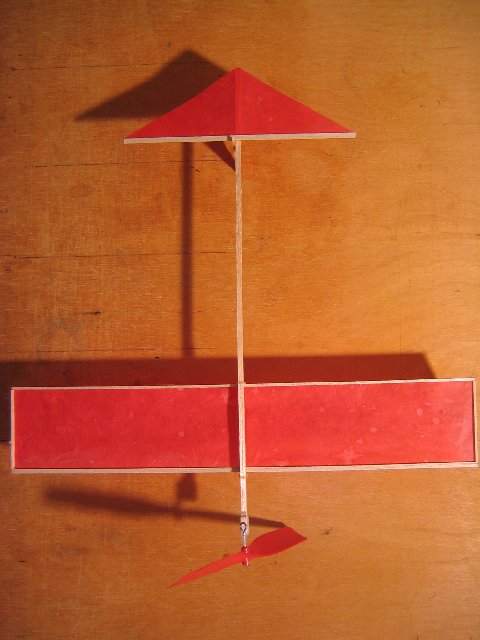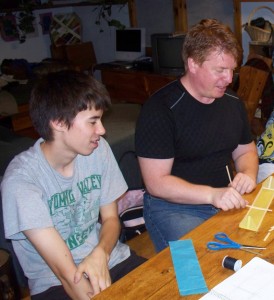Category Archives: Experimental

12 minute airplane
freeflightml
I met Gary Hinze on the FreeFlightML (Free Flight Mailing List). He send me this message in July 2009.
The proposition in the Free Flight chat was that the Squirrel could be built in 6m by an expert. I must say, I did it in six minutes but it wasn’t easy. 🙂 Here is his message:
It took me 12 minutes.
Darcy, I communicated with you when you first went on the Internet several years ago.
I just built my first Squirrel. I have always had a lot of trouble following directions. I made some changes. I hope they are improvements. You can see them all in this picture.
1. I used a 1/8″ x 1/4″ stick. Even this is heavier than necessary.
2. That necessitated a 1/8″ x 1/8″ x 1/2″ shim block so the Sig prop hanger would be a snug fit.
3. The stick tapers to 1/8″ thick in the last 2 3/8″ to make the tailplane parallel with the prop shaft.
4. The paper parts were cut out with cardboard templates. This wastes a lot less tissue. No scissors are necessary during construction. All wood parts are self locating on the paper patterns. (Several sets of tissue parts can be made at one time by stacking several sheets of tissue on top of each other.)
5. There is no center rib in the wing. The hold down stick does that job. It is glued in two places, to the wing leading and trailing edge spars, not to the paper.
6. There is no wing saddle. The hold down stick straps directly to the top of the stick with two dental bands, doubled to make them pretty tight. The top ends of the hold down stick are sanded to 45 degree tapers to make it easier to roll the bands on.
7. The wing and tailplane papers were folded in half to make center line creases to locate the hold down stick on the wing and the tailplane on the fuselage.
8. 1/16″ square wood was used for the wing trailing edge, tip ribs and winglet spars.
9. The winglet spars were located 3/4″ back from the leading edge.
10. The wing was mounted with the paper on the upper surface. That gives the wing 2 degrees of effective incidence. Added to the 3 degrees of downthrust, that is 5 degrees attack angle. As designed, the wing has about zero degrees of effective incidence and 3 degree attack angle from the downthrust only.
11. No wing incidence shim is necessary.
12. The winglet spars are glued to the outer faces of the wingtips, due to the wing being “upsidedown”.
13. The fin spar is extended 1/4″ below the bottom of the stick to hold the motor. I may file a round indentation in the back of the spar to hold the motor in place. With the motor I intend to use, the motor will never come loose, unless it gets into a thermal, and in that case your motor dethermalizer will come into play. No toothpick or thread are necessary for the motor hook.
14. The back corner of the tailplane aligns exactly with the end of the stick. The root chord of the fin is 1/8″ longer than the root chord of the tailplane so it too aligns exactly with the end of the stick, but the fin spar can go directly in front of the tailplane spar. The bottom edge of the fin paper aligns exactly with the bottom edge of the stick taper.
The finished plane weighs 5.9 grams. I used 11# wood for the stick and 14# wood for the spars. I also used a Japanese paper that weighs 26 grams per square meter because the unsupported tissue edges seemed rather fragile in fine tissue. The distance between the hooks is 9 1/2″. I will use a handy 20″ loop of 1/16″ Tan Super Sport to fly it.
It could be made quite a bit lighter with lighter wood, thinner tissue with thread reinforced edges and a North Pacific 5 1/2″ prop assembly. That prop assembly weighs a gram less than the Sig unit because the prop is much thinner.
I moved the wing until I got a slow, steady descent. The CG was at 13/16″, about a third of the chord, pretty close to the winglet spar position.
There are 18 parts in this Squirrel.
1 1/8″ x 1/4″ x 12″ balsa motor stick
1 1/8″ x 1/8″ x 1/2″ balsa nose spacer
1 1/16″ x 1/8″ x 12″ balsa wing leading edge
1 1/16″ x 1/16″ x 12″ balsa wing trailing edge
4 1/16″ x 1/16″ x 2 1/16″ balsa wingtip ribs and winglet posts
1 1/16″ x 1/8″ x 2 1/2″ balsa fin spar
1 1/16″ x 1/8″ x 6″ balsa tailplane spar
1 1/16″ x 1/8″ x 3″ balsa wing hold down stick
1 tissue wing
1 tissue tailplane
1 tissue fin
2 dental hold down bands
1 5 1/2″ propeller assembly
1 19″ loop of 1/16″ rubber motor
I have not had an opportunity to fly it under power, finished it after dark, been warned by the police about being in the park after dark. I expect to have a chance to fly it tomorrow and report results.
Gary Hinze
Walk Along Gliders
Summer 2009 I visited Slater Harrison who’s a school teacher in Pennsylvania who has been building Squirrel model air planes as part of his science classes. We met on-line when Slater discovered the Squirrel design and started to build them with his students. The Squirrel is an excellent project for the classroom. Check out the education section of this Web site.
After a warm meal and a beer at his amazing home in the country, we got right down to talking about aircraft design and how to make things work better in the classroom. I built a Squirrel to show wood sizes and the techniques I was using.
I hadn’t really done much with walkalong gliders but Slater was very eager to show off his walkalong design that he had been working on. After he had flown it around is living room and kitchen area, I was hooked.
The next morning I had the privileged of visiting his classroom so he could show me the ropes of the walkalong glider. His classroom is great. All the chairs and such are in a square in the middle so that you can do a circuit around the classroom.
Slater showed me the techniques of flying the walkalongs that he had learned. We also built several gliders and ran them around the classroom. We experimented with a few of the design elements.
Here he is demonstrating the design. I think a walkalong is a great idea because of its simplicity. No elastic bands, propellers or anything like that. Further, it’s made from the pages of a phone book using clear tape and a piece of a straw. This makes for a fairly low cost project.
There is still a fairly steep learning curve for flying it.
You can get a sense of how much fun they are from this video.
An experimental modification that resulted in a slightly faster flying glider.
It wound up being fairly fast and even more challenging to fly. So it’s pretty clear that the trick is to get the flying speed down.
But you can sure get a sense of how fun it is from the video we took of it.
Longer coupled modification proves very difficult to fly
I theorized that a longer coupled design would be easier to trip so we could optimise the glide better. So I created one with a horizontal stabilizer (canard) in the front. I was able to get a good glide but it proved to be very difficult to fly. In retrospect this is because the lift is being applied to the wing and not to the canard area (because it’s too far away). So another thing I learned was that a walkalong needs to be a short coupled design.
Slater eventually got the long coupled design flying.
After a few tries, Slater got the long coupled design working. He held the cardboard at a more shallow angle.
I’m supposing that this increased the size of the wave that is lifting the airplane so that it includes the wing and canard.
I’m tempted to say that it’s just a matter of learning the new design but I still think that the long coupled design doesn’t work because it requires the cardboard for pushing the air. The stock design that Slater already had going could be flown with just his hands which is pretty cool.
More experiments with the long coupled design.
An interesting flight with the longer design showing the glide capabilities.
We played around with a few variations of the longer design as well as some other ideas.
We also looked at some tumblewing designs that he had on hand.
Tumblewing designs are incredibly easy to make out of tissue paper. They are easy to trim and fly well. Also fairly easy to fly.
I had a tumblewing on my drawing board and after seeing that I realize it’s already been done. And well done so I decided to drop that from my design lab.
A cool flight in the gym.
After we tinkered with the design for a while we did some experiments in the gym. I was able to get better flights in the gym but I still hadn’t mastered how to fly the walkalong gliders.
Slater and I did some dolly shots of some of the gliders so that he could include them in some of his videos. I did some of the shots with his scooter and some by foot. We did some stationary camera shots to try to calculate the glide angles as well. I’m curious to see what becomes of those videos.
I had the pleasure of staying at Slater’s place in the country in Pennsylvania. Very nice place. Here are a few random pictures from around his yard.
Make a motor stick out of 1/16th inch sheet
I was talking to my friend Bill Khul and we were agreeing that the cost of balsa really adds up when you’re making a lot of airplanes. We discussed some alternate materials but right after the conversation I made this alternate motor stick for the Squirrel that uses less balsa.
You can make a motorstick out of 1/16 x 3/8 inch balsa rather than 1/8 x 3/8 inch. That’s pretty thin but if you put a doubler for the first inch and a half or so, then it fits the standard propeller mount. If you then add a wing mount on top of it all the way back to the fin, then it stiffens the motor stick. The idea is to run it back to the rear motor hangar (toothpick). I added a doubler to the motor stick at the rear of the wing mount as well, just ahead of the toothpick. I then glued the toothpick and fin (don’t forget to add the tissue to the fin before attaching it to the motor stick). So the rear doubler and fin stick brace the toothpick fairly well. In this case I didn’t underhang the toothpick under the motor stick. Instead, it is flush and that is the location to glue to the horizontal stabilizer. After the Stabilizer is in place, you can glue a small block behind the toothpick to help get the elastic motor far enough from the motor stick if necessary.
I think there might be a weak point just behind the front doubler. Also, the toothpick is a bit flexible because it is not secured by sewing thread.
Interestingly, the motor stick is stiffer than a plain one but it’s more twisty. I wonder if this twistyness will provide some Stabilizer Tilt that will counteract torque? Food for thought!




















